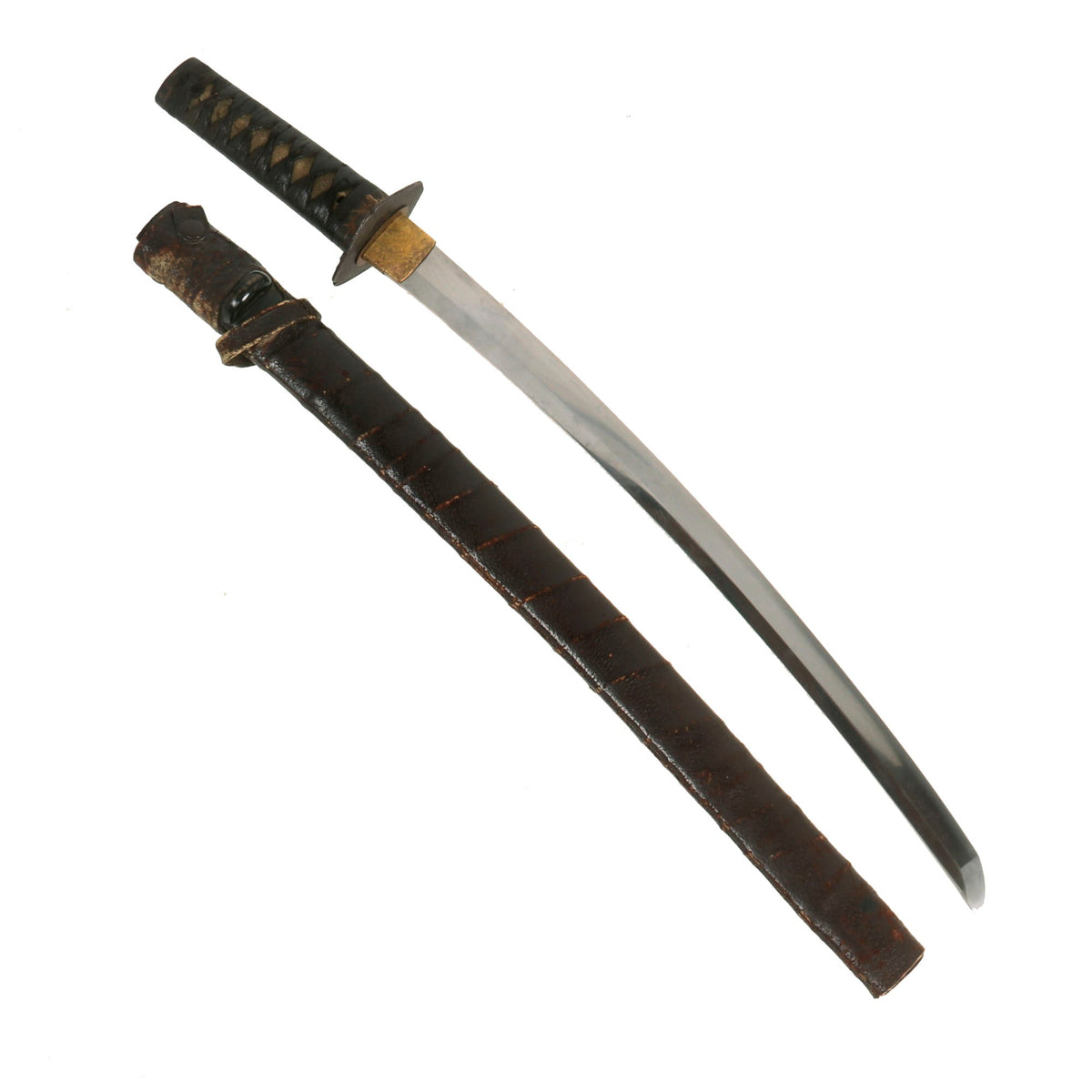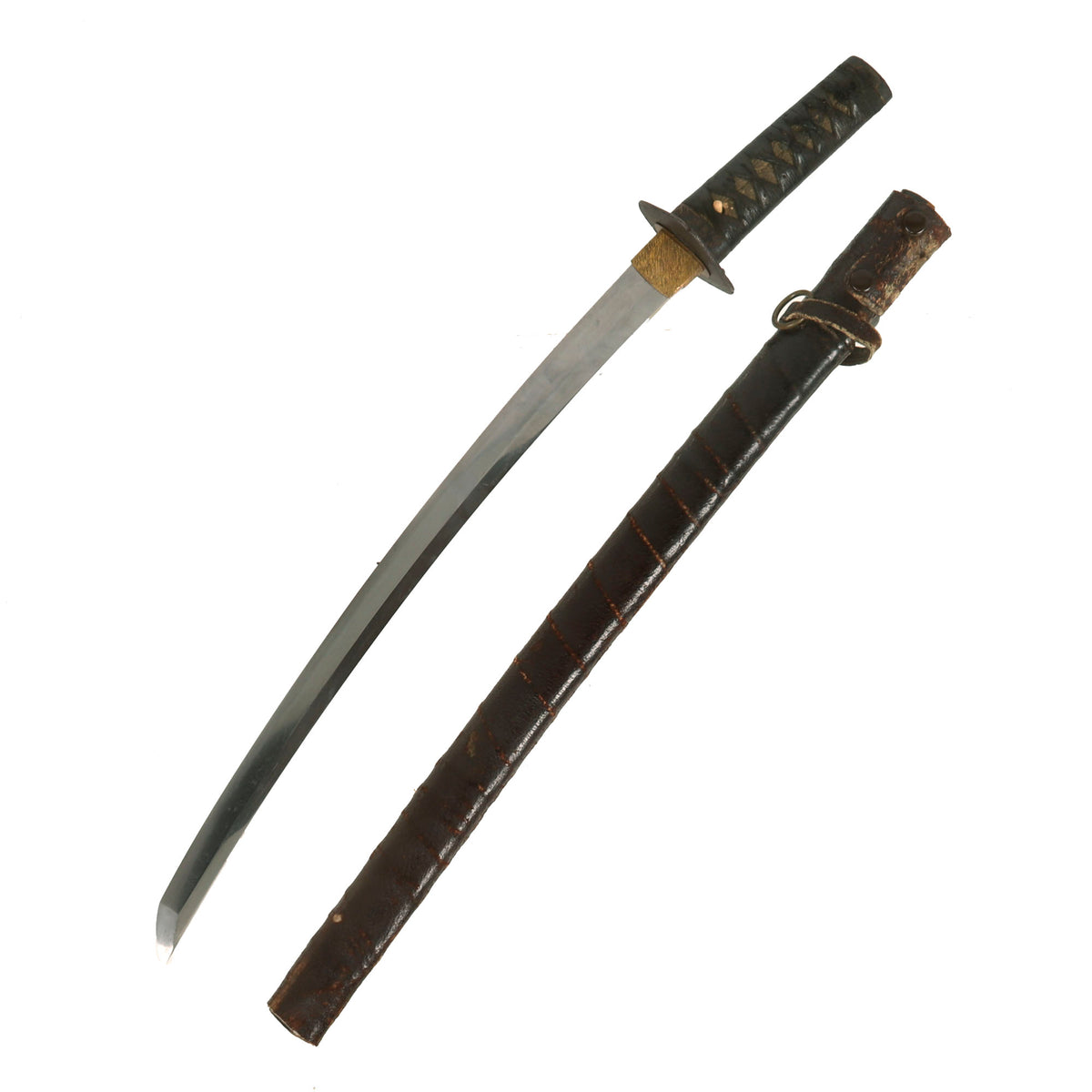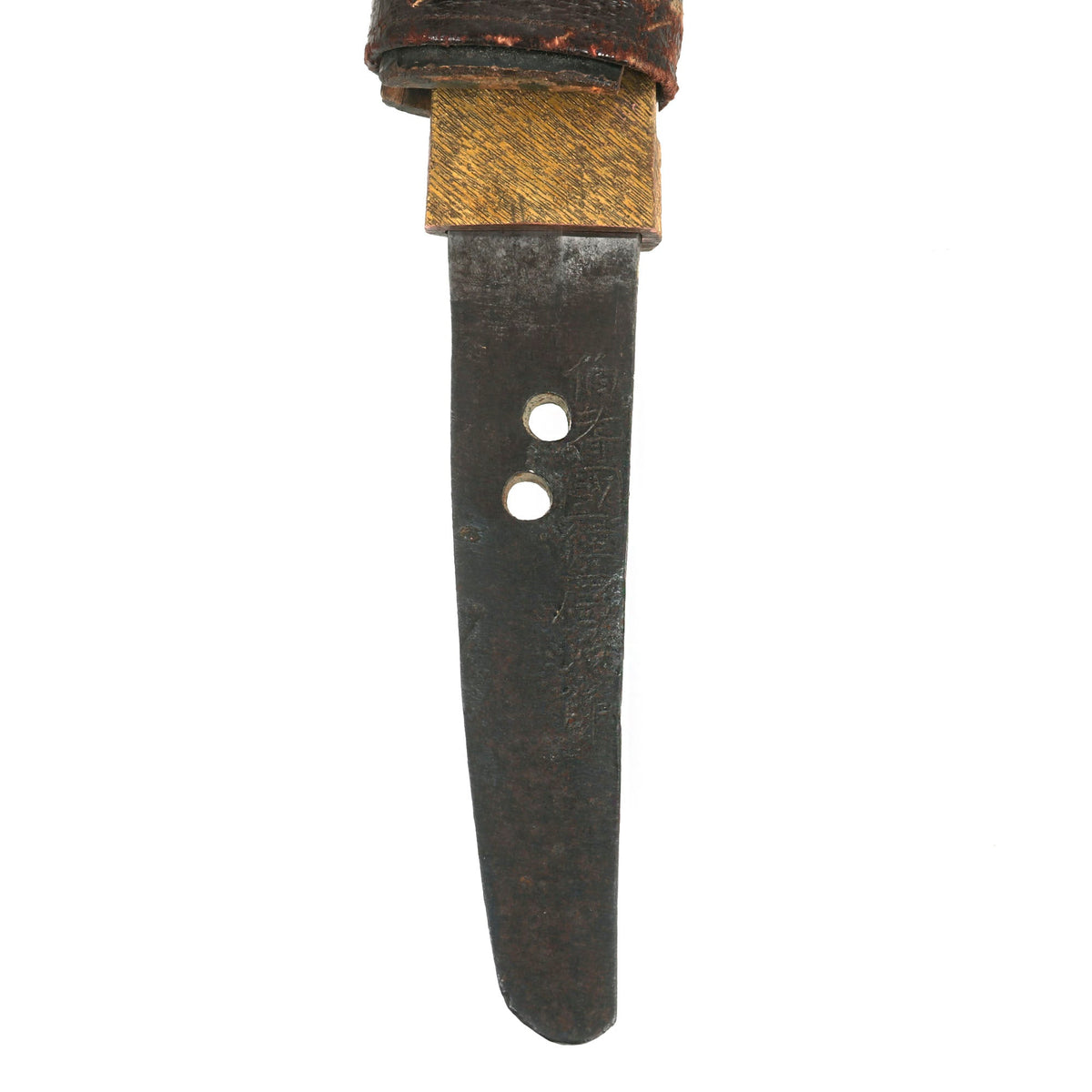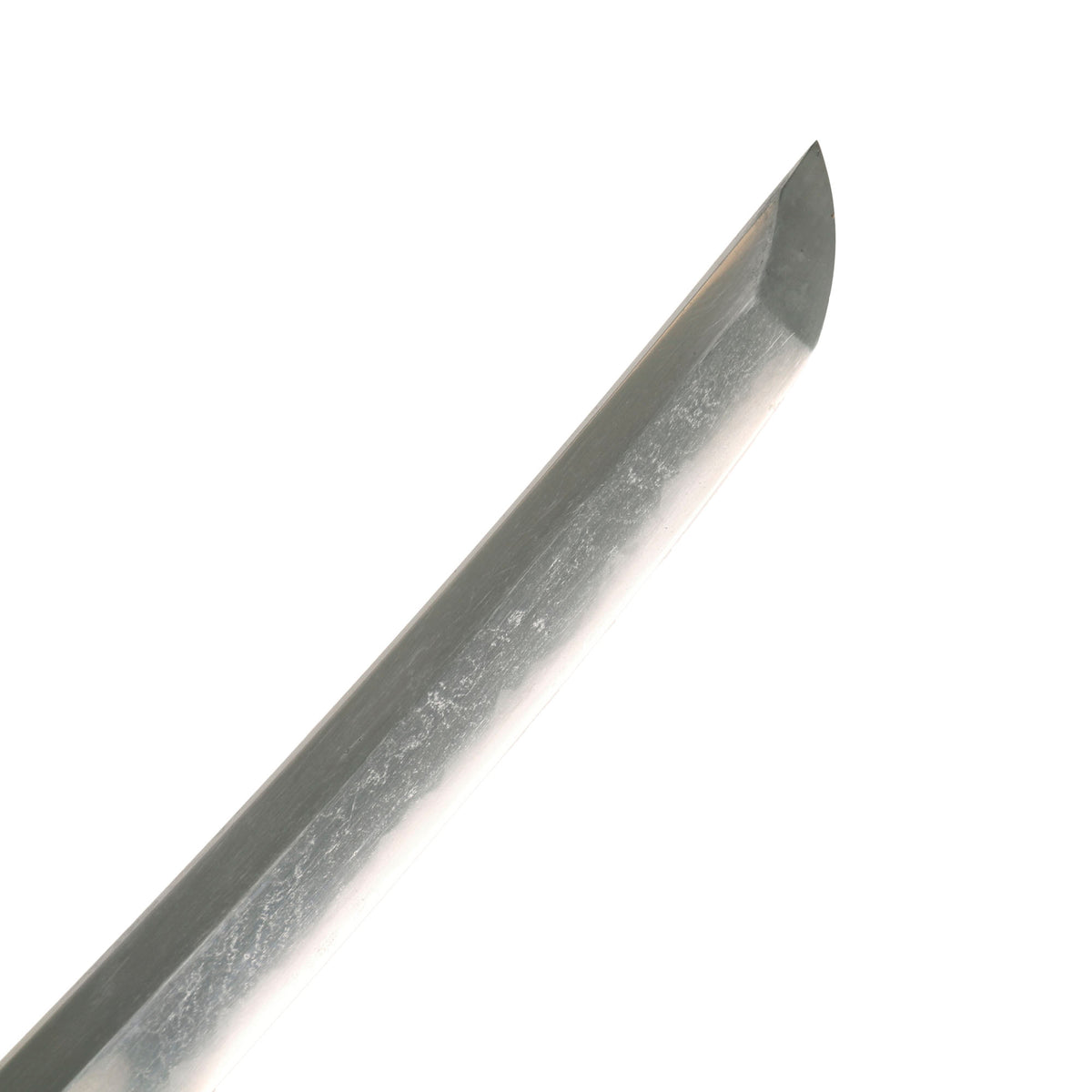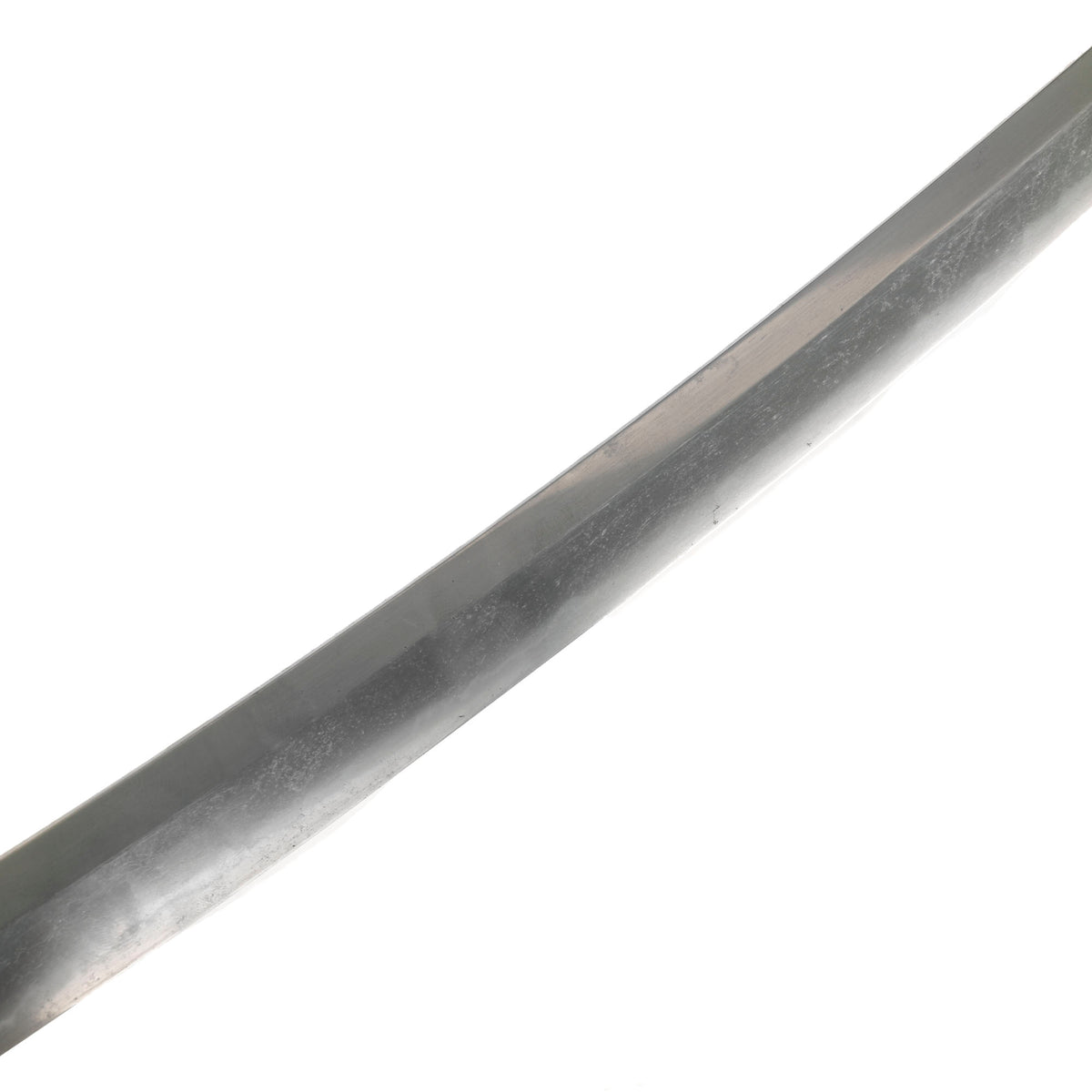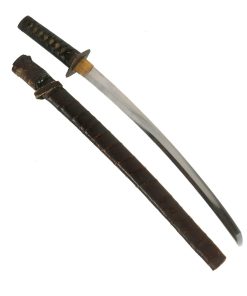Original 16th Century Japanese Handmade Ō-Wakizashi Short Sword by HIROYOSHI in Edo Period Fittings with Leather Scabbard Cover Original Items
$ 1.995,00 $ 498,75
Original Item: Only One Available. Wakizashi (脇差 “side inserted / companion sword”) is a general term for a sword with an edge between one and two shaku long (30 cm and 60 cm), predominantly made after 1600. Generally it is the short blade that accompanies a katana in the traditional samurai daisho pairing of swords, but may be worn by classes other than the samurai as a single blade, also worn edge up as the katana. Here we have a wonderful example in very good polish, which was refit during the Edo period, and maybe even used during WWII, as indicated by the leather field cover on the scabbard.
We had this sword examined, and we believe this example dates from the Muromachi period (室町時代 Muromachi jidai) of 1336 to 1573, during the later circa 1510. This is part of the period of Japanese swordmaking known as Kotō (古刀”old swords”), the the type of swords that later smiths treated as the goal they needed to achieve. The fittings are definitely of later manufacture, but are still well over a century old, being made during the Edo period of 1603 to 1868. Most likely this sword was brought back just after WWII, as many swords were turned in as required by the Allied forces.
This example has probably been remounted several times, as was common for Japanese blades that are several hundred years old. We can see that the edge length has been shortened by about half an inch, moving the blade notch (Ha-machi) farther up the blade, and it has two holes in the tang, which are both worn. Age and wear have made the file marks (yasurimi) on the tang faint, and given it a lovely patina. This has also removed the tagane-makura (raised area around the mei) and made the tagane (chisel marks) a bit faint, however the signature is still relatively easy to read, though due to wear it is very close to the edge of the tang.
As best we can tell it reads 伯耆國住廣賀作 – HŌKI KUNI JU HIROYOSHI SAKU, which translates to “Hiroyoshi made [this] in Hōki Province. They are a known smith, or several smiths, based in that produced swords during the Eishō (1504-1521), with some information listed here: HIROYOSHI. They were a member of the Tsunahiro school and are rated by by Hawley at at “40” and by Toko Taikan at ¥4M. There is also an example signed this way at the Metropolitan Museum of Art dated 1569, probably from a later generation. Definitely a good opportunity for further research!
The blade has the following period correct features:
– Folded steel blade (fold lines are evident on the spine and body of the blade)
– Holes (mekugi-ana) in the tang are punched and not drilled
– Visible vibrant temper line (“hamon”) running full length of blade cutting edge.
– Hada or Grain is visible throughout the blade surface.
– Blade has a proper geometric kissaki (tip).
– Blade wounds (kizu) or lamination artifacts are present on the blade. Both ware (lamination lines) and fukure (carbon pits) are visible.
Offered in very good condition, the polish on the blade of this example is in very good shape, showing light use and some cleaning since the last time it was polished. The aspects of the blade and temper line are easily seen in any type of light. It is still quite sharp, with no edge issues we can see, and should be handled with care. The blade length is approximately 18 ⅛” and overall length 24 ⅜”. It has a futsu 普通 (regular) Nakago with an Haagari (asymmetrical rounded) nakago-jiri (tang tip). The blade shape is SHINOGI-ZUKURI, which is the “standard” shape for most Katana and longer wakizashi. Many would term this an “Ō-Wakizashi” as the length is relatively close to a Katana.
The blade has a proper kissaki (tip) with a clear yokote (division between body and tip) and boshi (tip temper line). The main edge Temper line (hamon) is fully visible, and is a very attractive MIDARE (乱れ – irregular) shape. It has portions that resemble other Hamon patterns, making it a real joy to examine. Along the transition there are clear NIE crystals visible, with cloudy areas of NIOI in the body of the hamon, and some nice activity. The body of the blade (JI) also shows hada (肌 – grain), which is the ITAME (板目 – wood grain) pattern. The tip temper line (boshi) is of visible, and has a lot of internal activity, and looks to be the Ō-Maru (大丸 – large circle) shape, but it also has some HAKIKAKE (掃掛け – brush stroke) type shapes. With the long delay for traditional togishi polishing, blades like this that are ready to display are definitely in demand.
The tsuba (cross guard) is made of iron and is of the KAKU GATA (square) shape, with some simple copper inlay embellishments on the bottom. It has two Hitsu-ana accessory holes, one for the Kozuka (kogatana handle) and one for a kogai hair ornament. This allows the accessories to be taken out without unsheathing the sword. There is a single brass seppa to help keep the tsuba from wobbling. The sword has a plated copper “rain” pattern blade collar (habaki), which looks to be early 20th century.
The fuchi (collar) for the tsuka (handle) is made from iron, and has some lovely foliate and rice stalk designs. There is a single menuki, which looks to be a fish. The kashira (end cap) is made from iron, and has a lovely aged and oxidized patina. The stingray skin (Sa-Me) grip definitely shows wear, and the panels of skin have shrunk a bit over time. The black grip wrapping (Ito) shows wear from use. There is a single wooden securing peg (mekugi) still present which looks to be a recent replacement.
The sword comes well-fitting wooden scabbard (saya), which is covered with a very nice level field cover. The end is unfinished and flat, so it may have been cut down a bit, and it is fitted with a kurikata (knob) one one side for attachment of a sageo (sword cord), though there is no present. There is cracking off the scabbard throat, and it matches the age of the handle well. The field cover is in very good condition, and there is a brass hanger loop on the strap that goes around it.
A very nice late Muromachi Period wakizashi by a well-regarded known smith with a nice set of Edo period fittings! Ready to cherish and display!
Specifications:
Blade Length: 18 ⅛“
Blade Shape: Shinogi-Zukuri
Overall length: 24 ⅜“
Scabbard Length: 21 ½“
It has been over one thousand years ago that the art of making swords appeared in Japan. The swordsmiths of the time may not have known it but they were creating a legendary sword. The Samurai sword has seen combat in many battlefields. From the early days of the Samurai warrior to the fierce battles in the South Pacific during WWII.
Each hand-made Japanese blade (日本刀 – Nihonto) is unique because it is forged from multiple pieces of folded steel stock. A tremendous amount of work is dedicated to creating these pieces. They were an instrument of war as much as a beautiful artifact to adorn a room.
The traditional Japanese blade and mountings have grown to be one of the most highly desired military antiques.
Fast Shipping with Professional Packaging
Thanks to our longstanding association with UPS FedEx DHL, and other major international carriers, we are able to provide a range of shipping options. Our warehouse staff is expertly trained and will wrap your products according to our exact and precise specifications. Prior to shipping, your goods will be thoroughly examined and securely secured. We ship to thousands clients each day across multiple countries. This shows how we're dedicated to be the largest retailer on the internet. Warehouses and distribution centres can be located throughout Europe as well as the USA.
Note: Orders with more than one item will be assigned a processing date depending on the item.
Before shipping before shipping, we'll conduct a thorough inspection of the items you have ordered. Today, the majority of orders will be delivered within 48 hours. The delivery time will be between 3-7 days.
Returns
The stock is dynamic and we cannot completely manage it because multiple stakeholders are involved, including our factory and warehouse. So the actual stock may alter at any time. It's possible that you may not receive your order once the order has been made.
Our policy is valid for a period of 30 days. If you don't receive the product within 30 days, we are not able to issue a refund or an exchange.
You can only return an item if it is unused and in the same state as the day you received it. You must have the item in its original packaging.
Related products
Uncategorized
Uncategorized
Armored Burgonet Helmet & Polearm from Scottish Castle Leith Hall Circa 1700 Original Items
Uncategorized
Uncategorized
Australian WWII Owen MK1 Machine Carbine SMG Custom Fabricated Replica with Sling Original Items
Uncategorized
Uncategorized
Uncategorized
Uncategorized
Uncategorized
Band of Brothers ORIGINAL GERMAN WWII Le. F.H. 18 10.5cm ARTILLERY PIECE Original Items
Uncategorized
Uncategorized
Uncategorized
Uncategorized
Uncategorized
Uncategorized
Uncategorized
Uncategorized
Uncategorized
